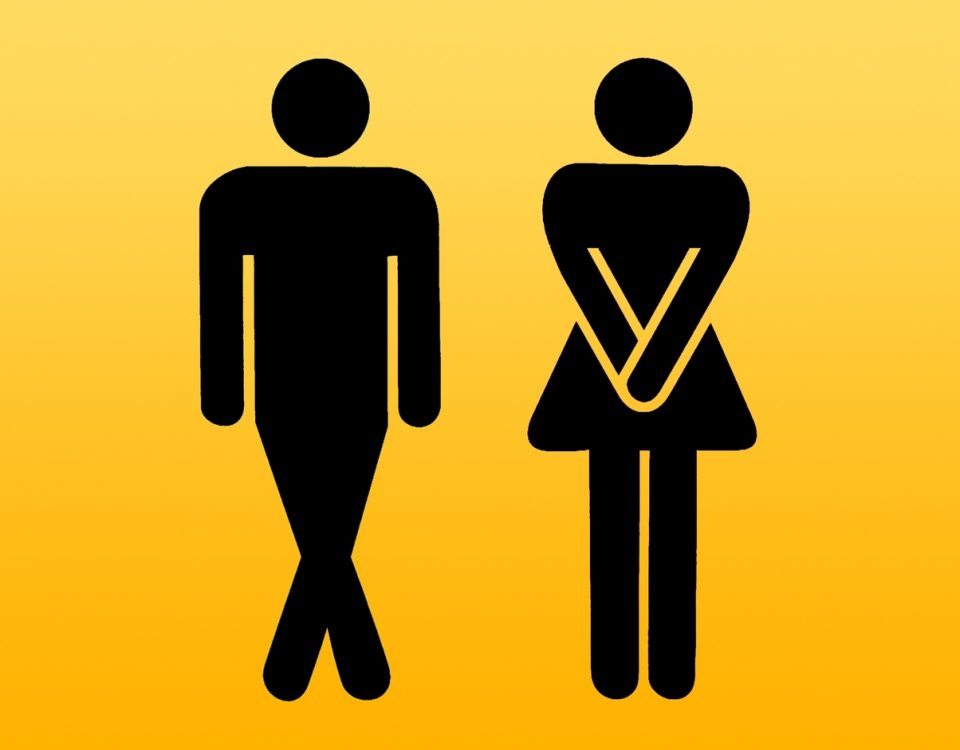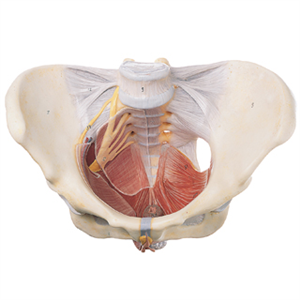The word prescription (Rx) in Latin means “to take”. These recommendations are meant for you to take into consideration and apply to your Yoga practice. I truly hope this helps you.
I’ve been a Physical Therapist, working with mostly injured yogis, since 2006. So many yogis I meet experience lower back pain and/or sacro-iliac (SI) joint dysfunction. And many times the structural reason is because they keep trying to “stretch it out” when the opposite is what’s needed. I believe there’s always an emotional, mental and energetic component to one’s healing. And that all of these need to be addressed when working with physical pain AND the physical component, the structure of your body, needs to be supported simultaneously. Even though the physical manifestation of pain typically has a root cause coming from an unconscious repressed emotional component, the pain is real. (A great topic for another article.) This article is mainly about supporting your structure, which leads to increased circulation, energetic flow, optimal postural strength and proper joint stability.
Many people who attend evening Yoga classes go from sitting at a desk all day to sitting in a car and straight into a Yoga class. A sitting, or forward bending position, of the lower back is also known as flexion and looks like a flattening of the natural lumbar curve (lordosis). In a lot of Yoga classes, there are many times double, if not triple, the amount of forward bends than there are backbends. Think how many times you stretch your hamstrings during a typical Yoga class. A lot of forward bending usually does not cause any problem right away. It could be months or even years into your practice before you notice any problems of taking your body in one direction excessively. However, over time excessive and prolonged forward bending can lead to structural issues and common misalignments. It usually takes one getting injured to really start paying attention, but I am hoping this will reach many before that happens. And if you do have pain during or outside of Yoga already, I hope you will apply some of these recommendations. Your back will thank you. 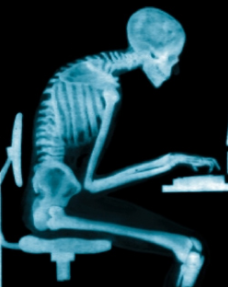
1. Avoid Flattening Your Lumbar Curve
The lumbar lordosis is a C-shaped curve, absorbs shock and supports the rest of the spinal curves as well. If the lower back curve is flattened, then the neck (cervical) curve is also flattened. These curves mimic each other and it is next to impossible to be upright in optimal posture without your lumbar curve.
You can see this in action sitting in a chair. Sit without any postural awareness and let the lower back round (posterior tilt of the pelvis) and watch how the head will go forward of the shoulders flattening the cervical curve. Now gently tilt your pelvis forward (the opposite of tucking your tailbone), so your low back has its natural curve and watch your head come back over your center of gravity. The low back and neck will both have a natural C-shaped curve (see pic below). The natural lumbar and cervical lordosis are both ideal for proper shock absorption, optimal posture and allow for our gait (walking) to be energetically efficient.
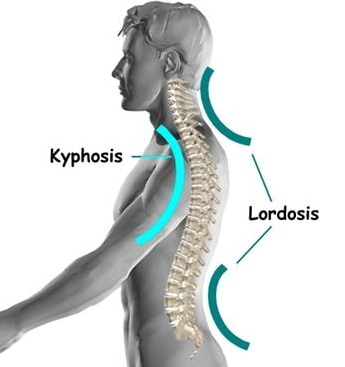
Think of how often you hear the cue “tuck your tailbone”. It is widely overused and often unnecessarily applied. It promotes the flattening of your lumbar curve by rolling the tailbone under the body. And many people do this by overly tightening the glutes, when you can perform the action gently by using your lower abdominals to lift the pubic bone up. Now don’t get me wrong, I’m not saying NEVER do this, as it naturally happens in child’s pose and when you bring your knee to your chest. I’m really speaking to the results of overdoing of an action. You can actually create space along the entire spine with axial extension, which is lengthening through the crown of the head and energetically rooting down toward the ground. This is more of a whole spine action and is less likely to over-do as “tucking the tailbone”.
Over time with predominantly practicing forward bends, the soft tissues of the back body get overstretched and weaken leading to a flattening of the lumbar curve. This can lead to looseness (laxity) in the ligaments and tendons, more pressure on the intervertebral discs, as well as increased chances of a lower back strain, hamstring muscle strain and disc injury. ***This is assuming you are not doing twice as many counterbalancing exercises or activities that would strengthen your natural lumbar curve.
The most amount of pressure you can place on the discs is with forward bending and twisting, so be extra mindful in seated forward bend/twisting postures. The back body, which includes the hamstrings, gluteals, paraspinal muscles and all the connecting ligaments need to be strong, not overstretched. This is important for posture and activities of daily living. It will help us combat the effects of our modern day society, ie. texting, typing, sitting, cooking, bending over to pick up anything, etc…. All of these activities we normally do during our day will give us more than enough flexion in the lower back.
Practice Tip: If you know you have a flattened lumbar curve, then in standing take your upper thigh bones back toward your hip sockets. Feel your weight more on your heels vs. the balls of your feet. This will encourage your natural lumbar lordosis. Avoid the cue “tucking your tailbone” when standing, which leads to hanging on the front of your hip and lower back ligaments and joints.
2. Avoid Overstretching Your Ligaments
Ligaments hold our bones together. They exist at every juncture where there are two connecting bones, such as between each vertebrae, between your thigh bone and pelvis, between your foot and ankle, etc…. Ligaments are the fibrous connective tissue we have all over the body, which hold joints together. They provide static stability, meaning when we are at rest they provide support to our bones and joints. They are designed to have a certain amount of tautness and are not designed to stretch much.
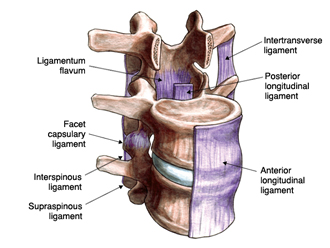
The thing about ligaments is that they DO NOT have the same ability as muscles to recoil back to the same position. You know how you stretch your hamstrings, they get tight again, you stretch them again, they get tight again, etc…? Well you can’t, nor would you want to, do this with your ligaments, as they do not act like muscles in this way.
Ligaments, as well as tendons, are not designed to stretch very much at all, as they naturally have less elastic tissue. Overstretching them may weaken the joint’s integrity and cause destabilization, which increases the risk of injury.
Practice Tip: If your elbows and knees hyperextend or if you are “double-jointed”, you may have a body type that is considered hypermobile or you have loose (lax) ligaments. In this case, it is extra important to have optimal alignment of your skeleton (read #3 below). Once you have optimal alignment, then engaging the muscles around the joint will increase stability and support around the area. This will help dynamically stabilize your joints and help counter the effects of the lax ligaments.
Hot Yoga Tip: This is especially important in hot yoga, as research has shown muscles do not uptake calcium as well in the heat. This means they do not contract as well in the heat to stabilize your joints and the ligaments are more at risk for being overstretched. You must have optimal structural alignment and muscle engagement to support your joints when practicing hot yoga.
3. Practice Keeping a Neutral Spine
Joint stability is the ability to maintain or control a joint’s movement or position. When you have joints in the body that are held together mostly by ligaments, such as the sacro-iliac (SI) joint, the joints’ stability is highly compromise when its stabilizing structures (ligaments) are overstretched.
Your sacrum is that upside-down triangular bone that is lodged between the two ilium (pelvic) bones. It is the most stable at 30 degrees. (see pic below) This just so happens to be when your natural lumbar lordosis is present and is also known as having a neutral spine. So especially if you have a lower back or SI joint injuries, it is best to keep this angle present. And it is just good practice to build the muscle memory around a neutral spine, which supports your whole structure all the way up to the neck. Energetically, it is important so that circulation gets to your legs and you can ground your energy. Again, you’ll get plenty of flexion in the low back just doing normal activities you naturally do every day.
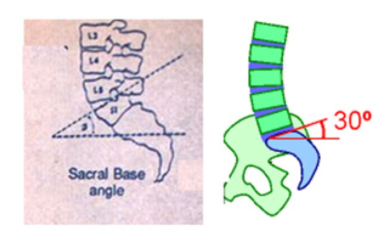
You have two SI joints where your sacrum meets your right and left ilium, or pelvic bones (as shown below). To put it simply, this joint transfers weight and force between your upper body and your legs. Strong ligaments hold this joint together and the joint typically has only a few millimeters of movement. However, there are many common misalignments that can happen in this area, including the sacrum, ilium and pubic bone. And these seemingly small misalignments can feel like something is terribly out of whack! To “Assess and Correct the SI Joint”, see my video here: https://www.youtube.com/watch?v=pQA1IadG51Y
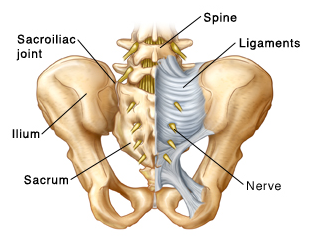 Posterior View of Pelvis
Posterior View of Pelvis
Practice Tips for Encouraging Neutral Spine:
- Bend your knees
- Take your upper thigh bones back toward your hip sockets, which will facilitate…
- …tilting the top of the sacrum forward to get that 30 degree angle (and create your lumbar curve)
- Lengthen your side body (from your hips to armpits)
- Bring weight to the back of your head, so it stays in line with your pelvis (pic below could use more of this)
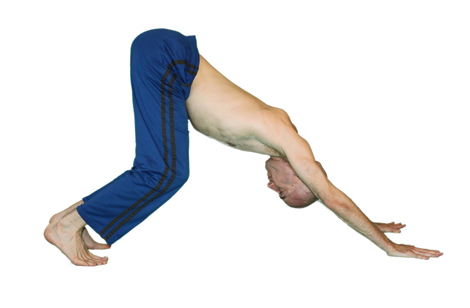
For more practices for Muscle & Joint Medicine, please visit www.YogaDoctors.TV/videos.
Dr. Somer Nicole
Founder of YogaDoctors.TV
Doctor of Physical Therapy
Kundalini and Hatha Yoga Teacher
CranioSacral Therapist & SomatoEmotional Release Practitioner
Reiki Master/Teacher


